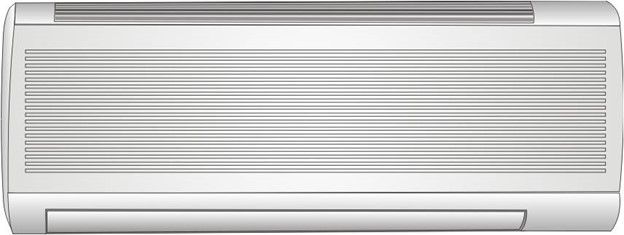
Outside ductless heat pump compressor
Mini-split heat pumps, also referred to as ductless heat pumps, are an alternative to radiators and baseboard heating, as well as a replacement for window units for cooling. It is a common cooling source for computer rooms and remote locations where ducting and hydronic systems do not have coverage.
Like standard heat pumps, these systems have two main components: an outdoor condenser/compressor, and an indoor air-handling unit. No ductwork is needed. Instead, a head unit is mounted on an interior wall or ceiling, with an accompanying unit outside. The outside unit extracts heat from the air, even when it’s cold. The refrigerant carries the heat directly to the head inside, which then delivers heated air to the occupied space. In warmer months, the system works in reverse for quiet, efficient air conditioning.


Some larger, commercial-scale heat pumps are called variable refrigerant flow (VRF) systems. Variable refrigerant flow refers to the system’s ability to control the amount of refrigerant flowing to each air handler. With VRF technology, one outdoor unit can be connected to different air handlers (heads) that are heating or cooling in different zones. Some very high-end systems can even provide heating to one zone while simultaneously providing cooling to another. These types have an additional refrigerant line to each internal unit and a controller that directs them to pull heat from rooms calling for cooling and sending it to rooms calling for heating, rather than ejecting it to the outdoors. By moving the refrigerant from one zone to another, the system allows for some heat recovery. Systems with multiple heads can be used in different capacities and configurations, providing for additional individualized comfort control.
Inspection Procedure and Concerns for Mini-Split Heat Pumps
The operational testing and inspection process for mini-split heat pumps is similar to that of any other heat pump system. Hence, each unit has individual controls typically operated by remote control. Sometimes the most difficult portion of the inspection is locating the remote control itself.
Commercial property inspectors should turn on the unit using the remote control/thermostat and select the heating or cooling setting to test accordingly. The outdoor unit should turn on and be relatively quiet. These units operate at a quieter level than conventional outdoor condensers. The interior unit will have a mechanically operated louver system that opens, and the interior blower will begin to distribute air. This air will be warm or cool, depending on the mode in which the system is operating. If conditioned air is being delivered, then the system is operating properly.
These units also have an internally installed drip pan. This pan is located under the evaporator coil. This pan is permanently plumbed to an appropriate discharge point. Each installation must have a discharge point, and this point might not be easily located or accessible. Inspectors should note any leaks in the condensation system, poor temperature, and system failure.
Takeaway for Commercial Property Inspectors
Mini-split heat pumps are also commonly referred to as ductless heat pumps because this type of unit does not require ductwork to distribute conditioned air. This type of unit consists of an outdoor condenser/compressor and an indoor air-handling unit. The outdoor units are mounted on the wall or on a concrete or stone pad outside, and refrigerant tubing and control wiring connect the inside and outside units through a small hole in the wall.
Commercial property inspectors should test each unit at the property using the provided remote control. In some cases, it may be challenging to locate the remote control. Additionally, inspectors should report on the general condition of each interior and exterior component of the mini-split system. Download CCPIA’s Mini-Split Heat Pump Inspection Checklist for additional information about inspecting these systems.
Article Written By: Rob Claus, CMI® and Maggie Aey
Additional Resources for Commercial Property Inspectors:


